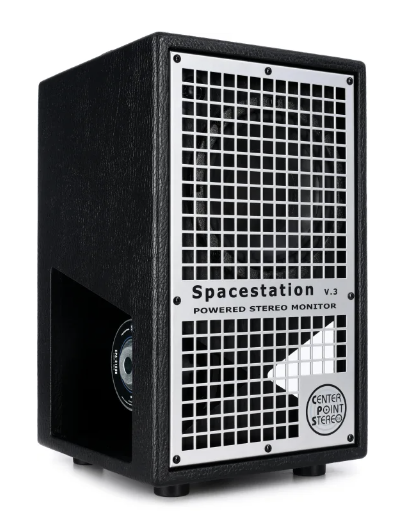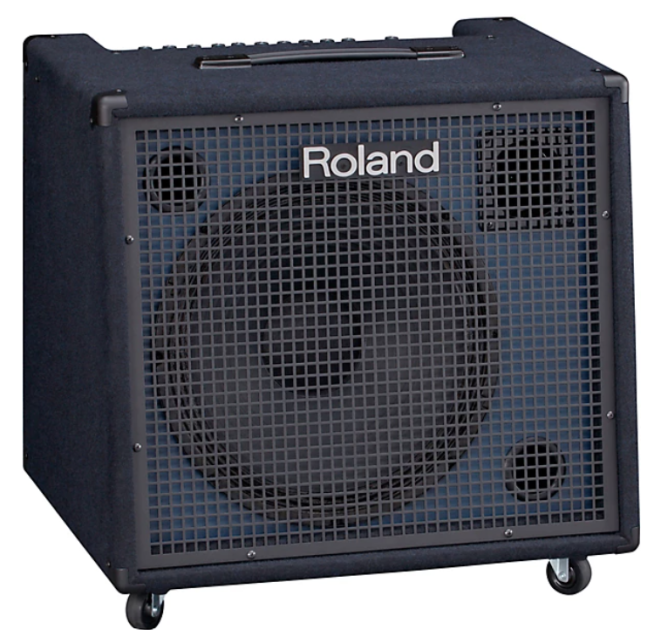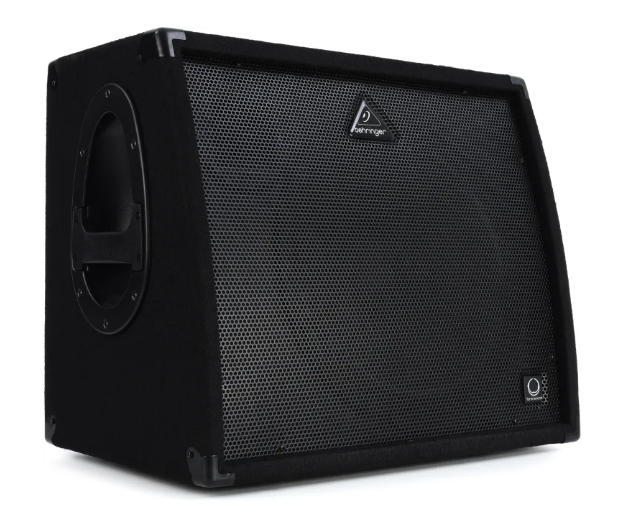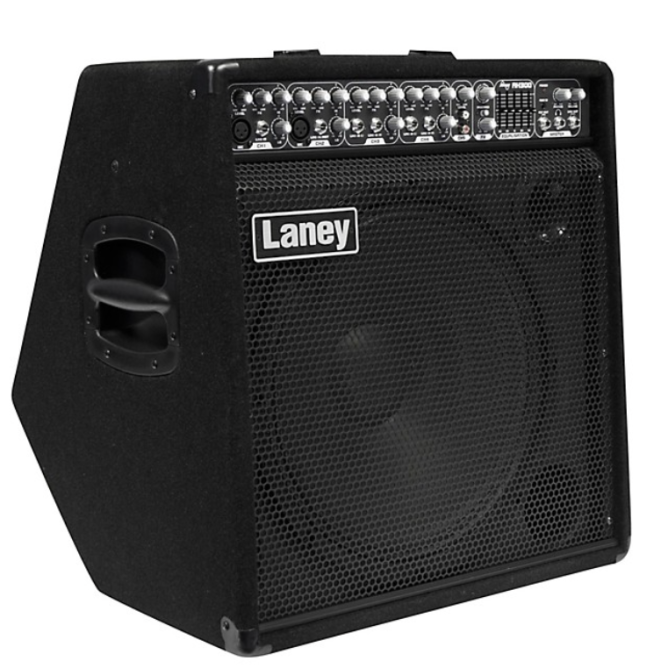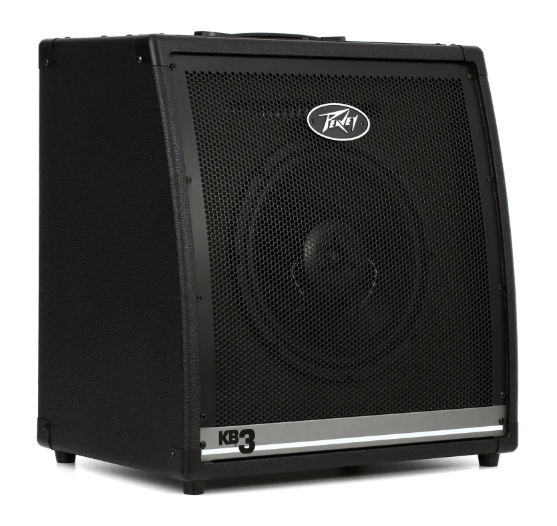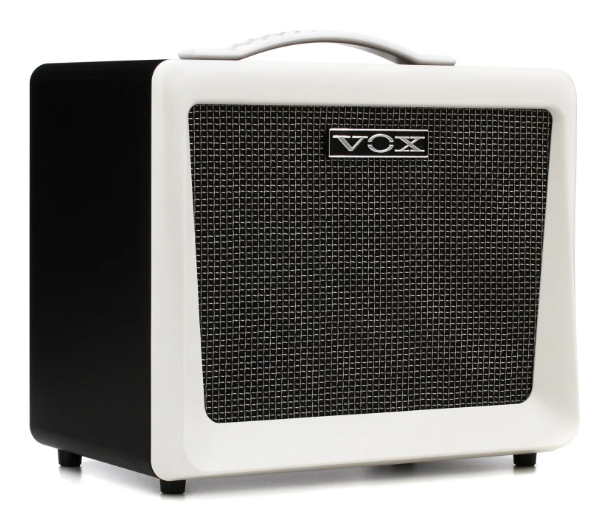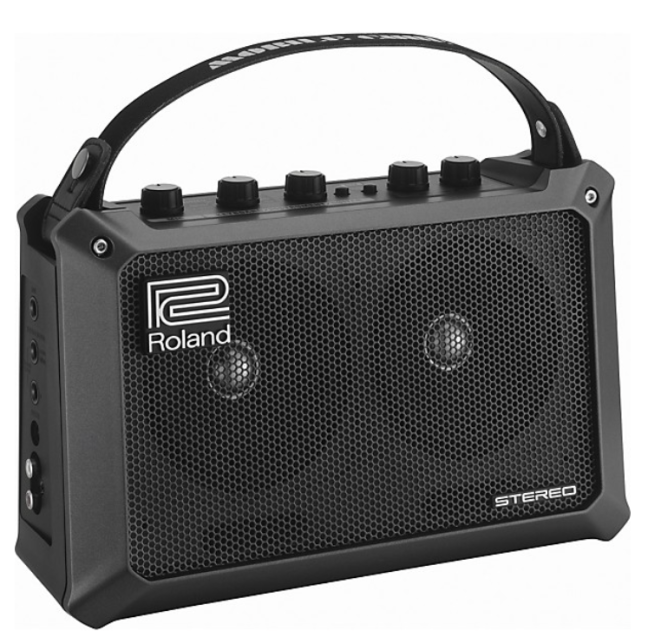In a way, a keyboard amplifier should do the exact opposite of what a guitar amp does.
While amplifiers for bass or electric guitars tend to add their own coloration and vibe to an instrument, a keyboard amp should give you a neutral and clean signal across the spectrum. Not to mention the frequency response, which is way wider in an amplifier designed for keyboards and synths.
Don’t worry if this sounds already too confusing. Today, we’ll look into what I believe are the best keyboard amps available now, and identify which one will work best for you, based on your gear and needs.
Whether you’re practicing the piano at home, performing live with your synth, or anything else in between, I’m sure that by the end of the article, you’ll know which amp can improve your playing experience.
And although the best keyboard amp on this list might be prohibitively expensive for many keyboard players, below you'll find plenty of other options for all budgets to make the most of your synth sounds!
Quick Summary of the Best Keyboard Amps
- Aspen Pittman Designs Stereo Spacestation V.3 (Best Overall)
- Roland KC-600 (Most Versatile)
- Behringer Ultratone KXD15 (Best for Solo Artists)
- Laney AUDIOHUB AH300 (Best for Large Venues)
- Peavey KB 3 (Best Small Keyboard Amp)
- Vox VX50KB (Best for Small Venues)
- Roland Mobile Cube (Best Practice Amp)
Best Keyboard Amps of 2024
Best Overall
SPECS
- Power: 280W (Tri-amped)
- Channels: 2
- Inputs: 2 x 1/4" (left, right)
- Outputs: 1 x 1/4" (subwoofer out)
The Aspen Pittman Designs Stereo Spacestation is the ultimate solution for keyboardists playing live: 280W of power, tri-amped, and with a sound that’s as clear as it is powerful, it works magnificently with both synths and acoustic-like instruments.
Its main feature is undoubtedly the CPS-patented technology that creates a 300-degree sound field from a single cabinet, meaning you get a wider sound dispersion than traditional stereo systems.
The uniform sound distribution is further enhanced by the speaker's width control feature, which allows you to adjust the spread of the sound and makes the amp adaptable to different environments.
Like I said, there’s nothing like this keyboard amp. The sound distribution and power offered by the Spacestation allows you to cut through the frequencies of every other instrument, and reach your audience wherever they are. It’s not cheap, but if you’re serious about your craft, the Spacestation is worth the investment.
What Could Be Improved:
- Pricey
- The plethora of features makes it a bit counterintuitive
Most Versatile
The Roland KC-600 keyboard amplifier is a no-nonsense keyboard amplifier with a versatile sound and deep base, loud enough for live shows and with plenty of connectivity options.
SPECS
- Power: 200W
- Channels: 4
- Inputs: 8 x 1/4" line, XLR mic input, RCA
- Outputs: Subwoofer output, Stereo output
The Roland KC-600 comes with a 200-watt output and a 15-inch speaker paired with a horn tweeter that brings to life a rich and detailed sound across the spectrum. The amp has four channels, including an input for microphones, which makes it a great option if you need to switch between sound sources.
An interesting evolution compared to the older members of the KC series is the possibility of linking the amp with another KC-600 to create a stereo sound or connecting it to a subwoofer to improve bass response.
Another feature I like is the rotary controls you can use to adjust levels and EQ: they’re minimal, straightforward, and effective.
When put to test, the KC-600 reproduces every note with full clarity across the entire frequency range, and seems more than capable of withstanding even the most cavernous bassline without breaking a sweat.
All in all, the KC-600 is compact, built to last, and easy to carry around thanks to the solid wheels. It works well whether used for live performances or as a portable PA system.
What Could Be Improved:
- Built-in effects leave much to be desired
Best for Solo Artists
The Behringer Ultratone KXD15 is a powerful amp with a built-in mixer, a wide array of effects, and virtually everything a keyboardist needs for live performance and beyond.
SPECS
- Power: 600W
- Channels: 4
- Inputs: XLR, 1/4", RCA stereo, and footswitch inputs
- Outputs: XLR, 1/4" stereo link, sub out, and headphones
The KXD15 is a perfect mix of power and precision: with a 600W power output and a 15" Turbosound speaker with a 1" high-frequency driver, the KXD15 gives you a level of clarity and depth that works well in any environment, especially when you want your keyboard or synth to stand out on stage.
What I love the most about the Behringer Ultratone KXD15 is the iconic Klark Teknik effects processor, with its 100 carefully crafted presets to create your sound signature, and the possibility to link it to an extra amplifier for an immersive stereo amp effect.
The Ultratone KXD15 has a 4-channel stereo mixer and a 7-band graphic EQ, which gives you a plethora of options when mixing multiple sources to fit the environment you’re in. It also comes with a useful FBQ feedback detection system that keeps your sound artifact-free.
Sturdy and incredibly versatile, the Ultratone KXD15 is the perfect option for touring artists who need a factotum amplifier!
What Could Be Improved:
- Hard to carry around.
- All those features can be overwhelming.
Best for Large Venues
The Laney AUDIOHUB AH300 is a compact keyboard amp that offers a crystal-clear sound and five channels you can use to connect an entire band. This amp is a must-have for artists who need a compact but powerful amp for their medium-size gigs and rehearsals.
SPECS
- Power: 300W
- Channels: 5
- Inputs: XLR, 1/4" TS, RCA, 1/8" Aux in, Effects Return
- Outputs: 1/4" TRS Alt Out, Headphones, Line Out, Effects Send
The AUDIOHUB AH300 comes with a remarkable 5-channel input option that makes it ideal if you’re planning to amplify multiple instruments with it, and offers a straightforward 5-band graphic master EQ to give you total tonal control when you’re doing so.
Plus, it features an FX loop and some crucial onboard digital effects, like reverb, chorus, and multi-FX.
The Laney AH300 comes with a 300W output, 15-inch speaker, and a high-frequency horn, bringing to life a rather neutral yet distinctive Laney signature tone that works well across genres.
This amp is built to be both robust and portable, so it’s a great option if you’re a touring artist or carrying your gear around a lot.
All in all, the AH300 is a super practical amp you can move easily and use for multiple purposes: the dual-position cabinet makes it perfect as both a stage monitor and amplifier, so chances are you’ll keep this amp for years thanks to its versatility and sound quality.
What Could Be Improved:
- Not cheap
Best Small Keyboard Amp
The Peavey KB 3 is more than just a keyboard amp: it’s an amplifier that sounds magnificent however you use it, whether to amplify your synth or acoustic guitar. Its 60W of power makes it loud enough for home studios, rehearsals, and small venues.
SPECS
- Power: 60W (80W with extension cab)
- Channels: 3
- Inputs: 5 x 1/4", 1 x XLR
- Outputs: 1 x XLR, 2 x 1/4", 1 x TRS (headphone)
If you’ve spent any amount of time in a rehearsal room, I’m pretty sure you've seen the Peavey KB 3 many times already!
It’s the kind of amp that works well with everything and doesn’t occupy much space, so many rehearsal spaces use it as a go-to amp for anything, from electronic drums to vocals, and of course, keyboards.
Despite its compact size, the KB 3 packs a punch. The 60 watts of power (extendable to 80 watts with an external cabinet), the 12" speaker and the tweeter work in unison to provide a clear, realistic soundstage across all frequencies.
While more than enough for rehearsal with a band and home practice, 60 watts might not be enough for live shows, and I’d recommend not pushing the KB 3 too hard.
It comes with three separate channels, and each channel has a 2-band EQ that gives you a rather basic yet essential control over your sound. The first channel has a dedicated mic input for vocals, which I think makes it a great option for songwriters and small touring bands.
And the balanced XLR main out allows you to connect it directly to PA speakers, should you ever have to perform in larger venues.
What Could Be Improved:
- Basic tonal shaping options
- At high volumes, the sound gets distorted fast
Best for Small Venues
Featuring Nutube circuitry, the compact and lightweight Vox VX50KB offers a rich analog tone that will enhance the sound articulation of your gear.
SPECS
- Power: 50W
- Channels: 3
- Inputs: 2 x 1/4" (keyboard), 1 x 1/4" (line/mic), 1 x 1/8" (aux input)
- Outputs: 1 x 1/4" (out), 1 x 1/8" (headphones)
Vox never disappoints. Over the years, the British manufacturer has managed to release accessible and reasonably-priced products for musicians of all levels, while maintaining its distinctive sound signature. The Vox VX50KB is no exception.
Despite its small size, the VX50KB can be impressively loud: 50W of power, a specially optimized bass-reflex cabinet and a single 8” coaxial speaker, all carefully designed to bring to life a broad dynamic range of sounds, from analog synths to warm vocals.
The most interesting feature of the VX50KB is its Nutube circuitry, which adds a warm and rich texture to the sound typical of tube amps but without all the problems that come with them (weight and maintenance). It also has a three-channel input capability for more complex setups.
Lightweight, analog-like, and eye-catching, the VX50KB might not be powerful enough for big stages, but it's definitely a keyboard amp that can take your sound to the next level in small venues and rehearsal rooms.
What Could Be Improved:
- A more detailed EQ would be ideal
Best Practice Amp
SPECS
- Power: 5W (2.5W per channel)
- Channels: 3
- Inputs: 1 x 1/4" (instrument), 1 x 1/4" (mic), 1 x 1/8" TRS (aux in), 1 x Dual RCA Stereo
- Outputs: 1 x 1/8" (headphones)
The Roland MOBILE Cube is designed for musicians on the move and offers a rich stereo sound experience that’s surprising for its size.
This amp is light enough to fit in a backpack and comes with 15 hours of battery life (you can also buy a 9V DC power supply separately). It can be a great companion for casual jams, camping trips, and more.
The MOBILE Cube comes with an impressive array of effects: onboard stereo chorus, reverb, and a Wide effect to broaden your soundstage. When used wisely, these sound customization options make the amp sound much bigger than it actually is and give the sound a dimensional quality that will add depth to your keyboard or synth.
It also comes with a tone knob for EQ adjustments and a 3-channel mixer to connect multiple sources simultaneously.
All in all, this is a phenomenal amp if you’re a busker, perform in small venues, or simply want to take your instrument with you on holiday. It’s reasonably priced and built with the lasting quality Roland is known for.
What Could Be Improved:
- For home practice and small gigs, only
- Power supply not included
Best Keyboard Amps Buyer’s Guide

Now that we have a list of possible candidates, let’s find out more about how to choose a keyboard amplifier based on your needs and budget. Below you’ll find what I think you should look for when choosing an amplifier for your electric piano or synth.
Power
Let’s start by defining the relationship between wattage, volume, and headroom.
Wattage is the amp's output power, i.e., how loud it can get without distorting the sound. Headroom is the amp's ability to handle sudden volume peaks without distortion. Higher wattage translates into greater volume and headroom.
So, what does it all mean? If you have a high-wattage amp, you can reach higher volumes without distortion, but this usually means you’ll have a bigger, heavier, and more expensive amp to carry with you at all times.
Start by defining how powerful your amp should be. Do you use it for home practice, rehearsals, or gigs? And if the latter, how big are the venues? What kind of music do you play? Does your guitarist think he’s Van Halen? Is your drummer a Neanderthal with drumsticks?
These are all crucial questions you should answer before making a final decision.
Transparent Sound
Because of how different keyboards and synths can be, your amp should reproduce sound faithfully, without altering the tone. Ideally, a high-quality amp should have a crisp sound across the entire range of the keyboard, regardless of volume levels.
Chances are you’ll also want to keep your amp should you ever want to replace your keyboard, which is why tonal transparency is so important. This level of clarity will enhance the character of your musical instrument without unnecessary coloration that can mitigate certain frequencies or the keyboard’s sound signature.
Inputs and Outputs

Multiple channels allow you to connect more keyboards or other instruments simultaneously, which can be crucial if you’re a songwriter but also if you want more than one instrument to go through a single chain of effects.
Headphone outputs are just as crucial as they allow you to practice without disturbing anyone around you. You might need these features or not, but you should at least be aware of what your chosen keyboard amp can offer you based on your needs.
Once again, think about how you’re going to use your amp and choose accordingly. If you need plenty of inputs, options like the aforementioned Peavey KB 3 will work magnificently, but if that’s not a priority, a more portable Vox VX50KB might do just fine.
Portability
Speaking of portability, you might want to get an amp that won’t break your back whenever you have to move it, especially if you’re using it for regular gigs or tours.
Weight is important but not the only factor to consider. For instance, some amps might be heavy but still easy to move around because they have wheels, like the Roland KC-600. Usually, the more lightweight a keyboard amp is, the less powerful it is, so make sure you strike a balance between portability and your needs as a musician.
Built-in Effects
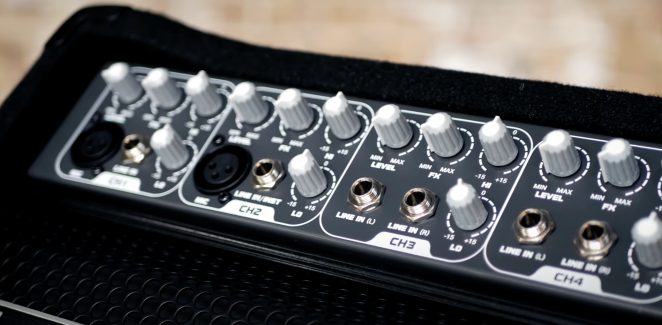
Standard built-in effects like reverb, delay, and chorus can save you time and money you’d otherwise spend on additional effects pedals, so they can definitely come in handy.
However, I think what’s most important in a keyboard amp is the EQ control effect: you can use it to customize your instrument’s frequencies to blend with the rest of your band, or adjust the sound based on the environment you’re in.
My recommendation is to look for an amp with detailed EQ functionalities, like the Ultratone KXD15, for instance.
FAQ
What wattage do I need for gigs versus home practice?
For home practice, a lower wattage keyboard amp between 10 and 30 W would do. As for gigs, it all comes down to how big the venue is, the genre you’re playing, and the instruments involved.
For small venues, anything between 50 and 100 Watts is usually loud enough and gives you headroom to work with. If you're playing in larger venues and with a full band, I'd go for 200 W or more to stay on the safe side.
Can I use a keyboard amp for other instruments or vocals?
Most keyboard amps are designed to cope with a wide frequency range, which means they can be used to amplify other instruments like acoustic guitars, electronic drums, and even vocals. That’s not the case with guitar or bass guitar amps, for instance, as they add coloration that might not work well with certain instruments.
By using a keyboard amp to amplify other instruments or vocals, you can save time, space, and money while also providing a consistent sound.
How do I connect my keyboard amp to a PA system?
To connect your keyboard amp to a PA system, use the line out or balanced XLR out on your amp, and connect it to the input channel on the sound system. Adjust the volume levels on both your amp and the PA to get the right sound balance without unwanted distortion.
What's the difference between a keyboard amp and a PA system or powered speaker?
All the keyboard amps are specifically designed to reproduce the wide range of frequencies created by keyboards or synths, whereas PA systems and powered speakers are designed to project sound to larger audiences.
They both can amplify keyboards, but most likely, you'll get a different sound depending on how the speakers or amplifiers interact with your instrument. All in all, having a keyboard-specific amp gives you more control over your sound signature.
Can I use studio monitors to amplify my keyboard?
Studio monitors are designed for critical listening in the studio, meaning they can reproduce the sound accurately across a wide frequency range. This characteristic makes them suitable as keyboard amplifiers, and while not a practical solution for live shows or rehearsals, they can be used for regular practice at home.
Final Thoughts

I hope this guide will help you choose the perfect keyboard amp for your needs.
To summarize, I'd recommend the Spacestation V.3 to anyone who wants a stellar keyboard amp that works well in any environment, has a unique sound, and will last a lifetime.
However, a valid and reasonably-priced alternative is the Vox VX50KB: it sounds great, it's powerful enough for rehearsals and small gigs, and it's a beauty to look at.
Have fun!
